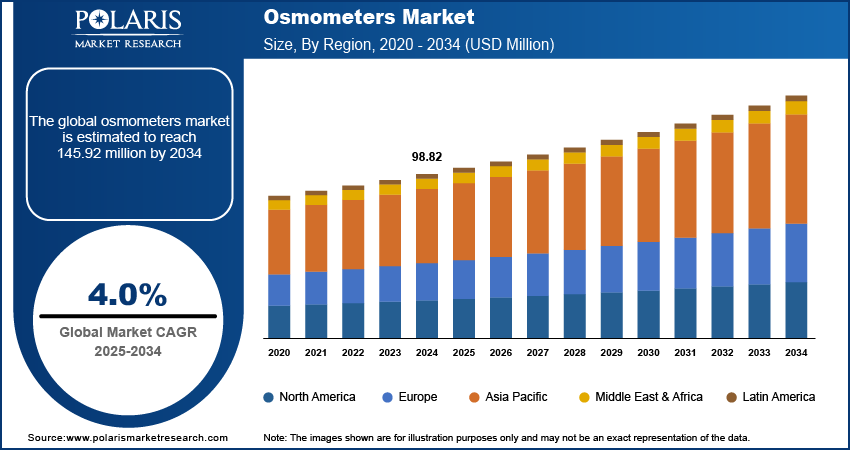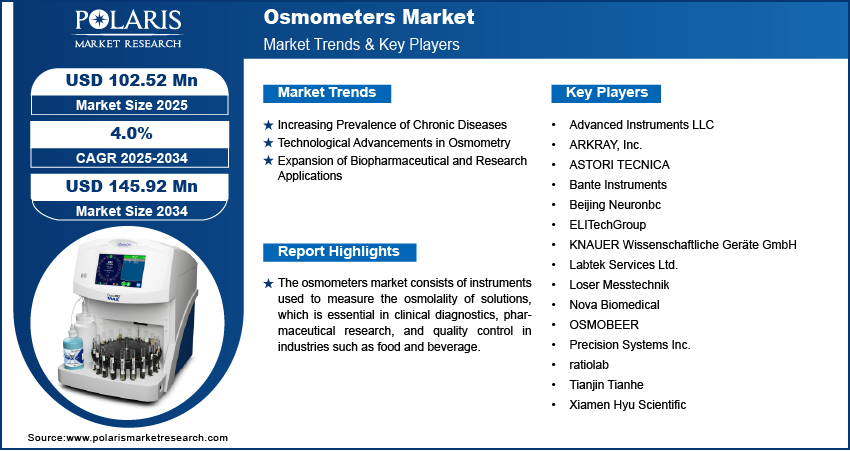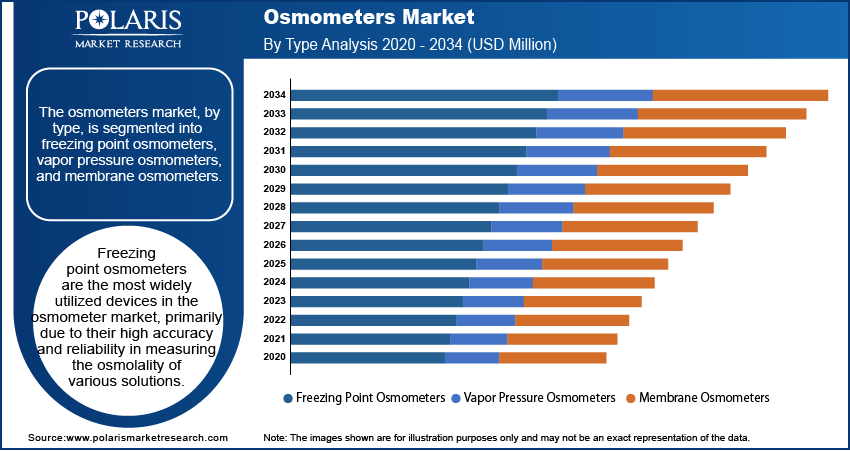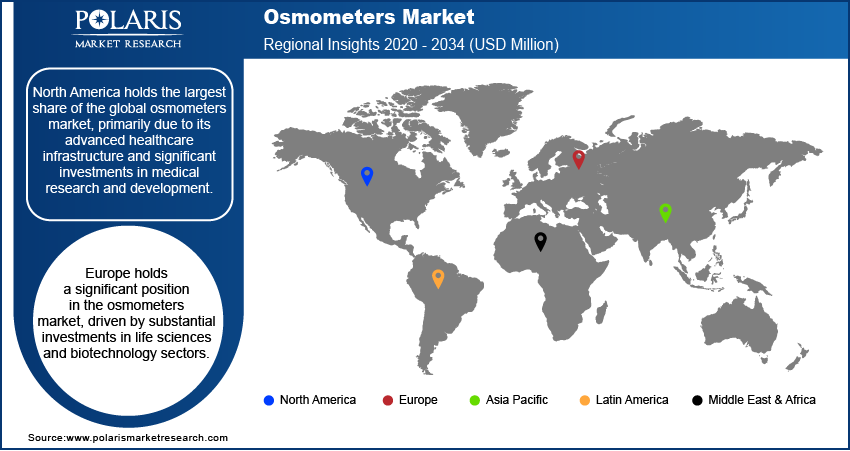
Osmometers Market Size, Share, Trends, Industry Analysis Report
: By Type (Freezing Point Osmometers, Vapor Pressure Osmometers, and Membrane Osmometers), Sampling Capacity, End User, and Region (North America, Europe, Asia Pacific, Latin America, and Middle East & Africa) – Market Forecast, 2025–2034
- Published Date:Apr-2025
- Pages: 119
- Format: PDF
- Report ID: PM3293
- Base Year: 2024
- Historical Data: 2020-2023
Osmometers Market Overview
The osmometers market size was valued at USD 98.82 million in 2024. The market is projected to grow from USD 102.52 million in 2025 to USD 145.92 million by 2034, exhibiting a CAGR of 4.0% during 2025–2034.
The osmometers market refers to the global industry focused on devices used to measure the osmolality of solutions, including biological fluids, pharmaceuticals, and industrial samples. These instruments are widely utilized in clinical diagnostics, biotechnology, pharmaceutical research, and food and beverage quality control. Key drivers of the market include the increasing demand for accurate diagnostic tools in healthcare, the growing adoption of osmolality testing in biopharmaceutical manufacturing, and advancements in laboratory automation. Additionally, regulatory requirements for drug formulation and quality control in industries such as pharmaceuticals and biotechnology support osmometers market growth.

To Understand More About this Research: Request a Free Sample Report
Osmometers Market Dynamics
Increasing Prevalence of Chronic Diseases
The rising prevalence of chronic diseases, such as diabetes and kidney disorders, significantly propels the demand for osmometers in clinical diagnostics. These instruments are essential for measuring osmolality in body fluids, aiding in the diagnosis and management of conditions like hyperglycemia and renal dysfunction. According to the World Health Organization (WHO), non-communicable diseases account for 71% of all global deaths annually, with diabetes contributing to 1.5 million deaths each year. This escalating burden necessitates advanced diagnostic tools, thereby driving the osmometers market demand.
Technological Advancements in Osmometry
Continuous technological innovations have enhanced the accuracy, efficiency, and user-friendliness of osmometers. Modern devices now feature automated sample processing, touch-screen interfaces, and connectivity with laboratory information management systems, streamlining laboratory workflows. In July 2022, Advanced Instruments introduced the OsmoPRO MAX Automated Osmometer, designed to increase productivity through automation in clinical laboratories. Such advancements improve diagnostic precision and expand the application scope of osmometers across various sectors, including pharmaceuticals and biotechnology.
Expansion of Biopharmaceutical and Research Applications
The biopharmaceutical industry's growth has led to increased utilization of osmometers in research and quality control processes. Accurate osmolality measurements are crucial for ensuring the stability and efficacy of biopharmaceutical products, such as monoclonal antibodies and vaccines. Additionally, osmometers are vital in cell culture monitoring and cryopreservation techniques. The expanding scope of biopharmaceutical applications necessitates precise analytical instruments, thereby bolstering the osmometers market development.

Osmometers Market Segment Insights
Osmometers Market Assessment – Type-Based Insights
The osmometers market, by type, is segmented into freezing point osmometers, vapor pressure osmometers, and membrane osmometers. Freezing point osmometers are the most widely utilized devices in the osmometer market, primarily due to their high accuracy and reliability in measuring the osmolality of various solutions. These instruments are extensively employed in clinical laboratories for analyzing bodily fluids, aiding in the diagnosis of conditions such as hyponatremia and dehydration. Their application extends to pharmaceutical manufacturing and quality control, where precise osmolality measurements are crucial for ensuring the efficacy and safety of injectable drugs and parenteral solutions. The versatility and precision of freezing point osmometers make them indispensable across multiple sectors, thereby securing their dominant position in the market.
Vapor pressure osmometers are experiencing significant growth within the osmometer market, driven by their specialized applications in research and industrial settings. These devices are particularly useful for determining the molecular weight of polymers and biological macromolecules, as they measure the reduction in vapor pressure caused by solute particles. This capability is essential in the development of new materials and in biochemical research, where understanding molecular interactions is vital. The increasing demand for advanced materials and biopharmaceuticals has led to a heightened need for vapor pressure osmometers, contributing to their rapid market expansion.
Osmometers Market Evaluation – by Sampling Capacity-Based Insights
The osmometers market, by sampling capacity, is segmented into single-sample and multi-sample. The single-sample segment dominates the osmometers market share, primarily due to their widespread adoption in various applications such as RNA therapeutics, high-concentration protein drug formulations, and gene and cell therapy. These instruments are favored for their ability to handle complex and concentrated samples, which were previously challenging to measure accurately. Technological advancements have further enhanced their capabilities, making them indispensable in bioproduction processes. For instance, the development of devices such as the OsmoTECH XT single-sample micro-osmometer has expanded the range of measurable osmolality, accommodating up to 4,000 mOsm/kg H2O. This innovation allows for precise assessment of viscous and highly concentrated samples, thereby reinforcing the prominence of single-sample osmometers in the market.
The multi-sample osmometers segment is experiencing the highest growth rate, driven by the increasing need for automation and efficiency in laboratories. Traditional single-sample osmometers require significant manual handling and operator time, which can lead to inefficiencies and a higher likelihood of errors. In response, multi-sample osmometers have been developed to automate various aspects of osmolality testing, thereby reducing manual intervention and improving throughput. Features such as integrated 2D barcode scanners, touch-screen interfaces, and intuitive software control enhance operational efficiency and data accuracy. These advancements address the evolving needs of laboratories for high-throughput and reliable testing solutions, contributing to the rapid adoption and growth of multi-sample osmometers in the market.
Osmometers Market Outlook – End User-Based Insights
The osmometers market, by end user, is segmented into hospitals, laboratory & diagnostics centers, healthcare companies, contract research organizations, contract manufacturing organizations, food and feed industries, and others. The laboratory and diagnostic centers represent the largest segment in the osmometers market, primarily due to their extensive use of these instruments for precise osmolality measurements in various applications. These centers rely on osmometers to analyze bodily fluids, aiding in the diagnosis of conditions such as electrolyte imbalances and kidney disorders. The high throughput and demand for accurate results in these facilities necessitate the adoption of advanced osmometry equipment, thereby solidifying their dominant market position.
The food and feed industries are experiencing the highest growth owing to the increasing need for quality control and assurance in food and beverage production. Osmometers are utilized to measure the osmolality of products, ensuring consistency, safety, and compliance with industry standards. As consumer demand for high-quality food products rises, manufacturers are investing in advanced osmometry solutions to maintain product integrity, thus driving significant growth in this sector.

Osmometers Market Regional Insights
By region, the study provides osmometers market insights into North America, Europe, Asia Pacific, Latin America, and the Middle East & Africa. North America holds the largest share of the osmometers market revenue, primarily due to its advanced healthcare infrastructure and significant investments in medical research and development. The region's high prevalence of chronic diseases, such as diabetes and kidney disorders, necessitates accurate osmolality testing, thereby increasing the demand for osmometers in clinical settings. Additionally, the presence of prominent market players and a favorable reimbursement environment boost the adoption of these devices across hospitals and diagnostic centers. The continuous technological advancements and a strong focus on laboratory automation in North America also contribute to its market dominance.
Europe holds a significant position in the osmometers market, driven by substantial investments in life sciences and biotechnology sectors. The UK, for instance, secured EUR 1.8 million in equity financing for its biotech industry in 2023, reflecting a strong commitment to advancing laboratory technologies. This financial support has led to the adoption of innovative osmometry equipment across research and clinical settings. Additionally, European countries emphasize stringent quality control in pharmaceutical and food industries, further propelling the demand for precise osmolality measurement instruments.
The Asia Pacific osmometers market is experiencing rapid growth, attributed to increasing healthcare expenditures and the rising prevalence of chronic diseases. Nations such as China, India, and Japan are investing heavily in healthcare infrastructure and research and development activities. This investment is fostering the adoption of advanced laboratory instruments, including osmometers, to enhance diagnostic accuracy and therapeutic outcomes. The expansion of pharmaceutical and biotechnology industries in this region also contributes to the heightened demand for osmolality testing devices.

Osmometers Market – Key Players and Competitive Insights
The osmometers market features several active and independent key players contributing to its growth and innovation. These include Advanced Instruments LLC, known for its comprehensive range of osmometers catering to clinical and industrial applications; Precision Systems Inc., offering specialized osmometry solutions; ELITechGroup, providing diagnostic instruments and reagents; ARKRAY, Inc., a prominent medical device manufacturer; and Nova Biomedical, recognized for advanced biotechnology and clinical diagnostic products. Other notable companies include ASTORI TECNICA, KNAUER Wissenschaftliche Geräte GmbH, ratiolab, Labtek Services Ltd., Loser Messtechnik, Beijing Neuronbc, Tianjin Tianhe, Xiamen Hyu Scientific, Bante Instruments, and OSMOBEER.
In the competitive landscape, Advanced Instruments LLC maintains a strong market presence through continuous innovation and a diverse product portfolio, addressing the needs of both clinical and industrial sectors. ELITechGroup enhances its market position by offering a wide array of diagnostic solutions, including osmometers, and expanding its global reach. ARKRAY, Inc. leverages its expertise in medical device manufacturing to provide reliable osmometry solutions, while Nova Biomedical focuses on integrating advanced technology into its products to meet the evolving demands of clinical diagnostics.
Emerging companies such as Xiamen Hyu Scientific and Bante Instruments are gaining traction by introducing innovative osmometry products with advanced features, such as enhanced accuracy and user-friendly interfaces. These companies are expanding their market presence through strategic partnerships and a focus on research and development. The competitive dynamics are further influenced by regional players such as Beijing Neuronbc and Tianjin Tianhe, who cater to the growing demand in their respective local markets. Overall, the osmometers market is characterized by a blend of established companies and new entrants, all striving to offer advanced, reliable, and efficient osmometry solutions to meet diverse industry needs.
Advanced Instruments LLC is a prominent provider of scientific and analytical instruments, specializing in osmometers, anaerobic jar systems, and neonatal bilirubin analyzers. Their products serve various sectors, including clinical diagnostics, biotechnology, and the food and beverage industry. In September 2020, Windjammer Capital announced an agreement to sell Advanced Instruments to Patricia Industries, a part of Investor AB, aiming to enhance the company's growth and innovation in the analytical instruments market.
Xiamen Hyu Scientific is a prominent player in the Automatic Osmometer Equipment Market, recognized for its dedication to research and development, resulting in high-quality and reliable osmometer products. The company's innovative approach integrates advanced technology to enhance measurement accuracy and reduce operational time. Emphasizing user-friendly designs, Xiamen Hyu Scientific caters to laboratories requiring efficient workflows. Its robust distribution network ensures quick access to products and support services, strengthening its competitive edge. The company's reputation for producing durable and precise measurement tools solidifies its position in the industry.
List of Key Companies in Osmometers Market
- Advanced Instruments LLC
- ARKRAY, Inc.
- ASTORI TECNICA
- Bante Instruments
- Beijing Neuronbc
- ELITechGroup
- KNAUER Wissenschaftliche Geräte GmbH
- Labtek Services Ltd.
- Loser Messtechnik
- Nova Biomedical
- OSMOBEER
- Precision Systems Inc.
- ratiolab
- Tianjin Tianhe
- Xiamen Hyu Scientific
Osmometers Industry Developments
- In July 2024, Advanced Instruments expanded its direct sales, service, and support teams for the Artel product line in Europe, aiming to enhance customer engagement and service efficiency in the region.
- In May 2023, Advanced Instruments introduced the OsmoPRO MAX Automated Osmometer, designed to improve productivity in clinical laboratories by offering automation and advanced data management capabilities.
Osmometers Market Segmentation
By Type Outlook
- Freezing Point Osmometers
- Vapor Pressure Osmometers
- Membrane Osmometers
By Sampling Capacity Outlook
- Single-Sample
- Multi-Sample
By End-User Outlook
- Hospitals, Laboratory & Diagnostics Centers
- Healthcare Companies
- Contract Research Organizations
- Contract Manufacturing Organizations
- Food and Feed Industries
- Others
By Regional Outlook
- North America
- US
- Canada
- Europe
- Germany
- France
- UK
- Italy
- Spain
- Netherlands
- Russia
- Rest of Europe
- Asia Pacific
- China
- Japan
- India
- Malaysia
- South Korea
- Indonesia
- Australia
- Vietnam
- Rest of Asia Pacific
- Middle East & Africa
- Saudi Arabia
- UAE
- Israel
- South Africa
- Rest of Middle East & Africa
- Latin America
- Mexico
- Brazil
- Argentina
- Rest of Latin America
Osmometers Market Report Scope
|
Report Attributes |
Details |
|
Market Size Value in 2024 |
USD 98.82 million |
|
Market Size Value in 2025 |
USD 102.52 million |
|
Revenue Forecast by 2034 |
USD 145.92 million |
|
CAGR |
4.0% from 2025 to 2034 |
|
Base Year |
2024 |
|
Historical Data |
2020–2023 |
|
Forecast Period |
2025–2034 |
|
Quantitative Units |
Revenue in USD million and CAGR from 2025 to 2034 |
|
Report Coverage |
Revenue Forecast, Market Competitive Landscape, Growth Factors, and Trends |
|
Segments Covered |
|
|
Regional Scope |
|
|
Competitive Landscape |
|
|
Report Format |
|
|
Customization |
Report customization as per your requirements with respect to countries, regions, and segmentation. |
How is the report valuable for an organization?
Workflow/Innovation Strategy
The osmometers market has been segmented on the basis of type, sampling capacity, and end user. Moreover, the study provides the reader with a detailed understanding of the different segments at both the global and regional levels.
Growth/Marketing Strategy
Companies in the osmometers market focus on product innovation, strategic partnerships, and geographic expansion to strengthen their market position. Advanced osmometers with automation features and enhanced accuracy are being introduced to meet the growing demand in clinical and research applications. Market players are also expanding their distribution networks and direct sales channels, particularly in emerging regions, to improve accessibility. Collaborations with healthcare institutions and research organizations help drive adoption, while digital marketing and participation in industry events enhance brand visibility. Additionally, compliance with regulatory standards and investments in R&D remain critical for sustaining growth in this competitive market.
FAQ's
The osmometers market size was valued at USD 98.82 million in 2024 and is projected to grow to USD 145.92 million by 2034.
The market is projected to register a CAGR of 4.0% during the forecast period.
North America held the largest share of the market in 2024.
The osmometers market features several active and independent key players contributing to its growth and innovation. These include Advanced Instruments LLC, known for its comprehensive range of osmometers catering to clinical and industrial applications; Precision Systems Inc., offering specialized osmometry solutions; ELITechGroup, providing diagnostic instruments and reagents; ARKRAY, Inc., a prominent medical device manufacturer; and Nova Biomedical, recognized for advanced biotechnology and clinical diagnostic products.
The freezing point osmometers segment accounted for the largest share of the market in 2024.
The multi-sample osmometers segment accounted for a larger share of the market in 2024.
Osmometers are laboratory instruments used to measure the osmolality of a solution, which refers to the concentration of solute particles per unit of solvent. These devices are commonly used in clinical diagnostics, pharmaceutical research, and the food and beverage industry to assess the concentration of dissolved substances in biological fluids, drugs, and other solutions. Osmometers operate based on different principles, including freezing point depression, vapor pressure, and membrane osmosis, depending on the application. In healthcare, they are essential for diagnosing conditions related to electrolyte imbalances, kidney function, and metabolic disorders.
A few key trends in the market are described below: Automation and Digital Integration – Increasing adoption of automated osmometers with digital interfaces and connectivity features to improve workflow efficiency in laboratories. Growing Demand in Clinical Diagnostics – Rising prevalence of chronic diseases, such as kidney disorders and diabetes, is driving the need for osmolality testing in hospitals and diagnostic centers. Expansion in Pharmaceutical and Biotechnology Applications – Increasing use of osmometers in drug formulation, quality control, and biologics development. Rising Adoption in Food and Beverage Industry – The growing focus on quality assurance and regulatory compliance is boosting the demand for osmolality measurement in food and beverage production.
A new company entering the osmometers market can focus on developing automated and AI-driven osmometry solutions to enhance accuracy and efficiency in clinical and research applications. Offering compact, cost-effective devices with minimal sample requirements can attract laboratories with budget and space constraints. Expanding into emerging markets, particularly in Asia Pacific and Latin America, where healthcare infrastructure is growing, can provide significant osmometers market opportunities. Strong emphasis on regulatory compliance, certification, and quality assurance will help build credibility. Additionally, partnerships with research institutions, hospitals, and pharmaceutical companies can accelerate market adoption and competitive positioning.
Companies manufacturing, distributing, or purchasing osmometers and related products, and other consulting firms must buy the report.
